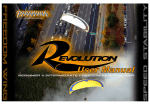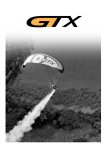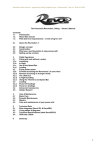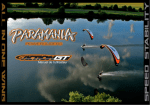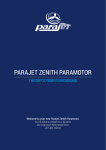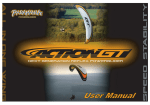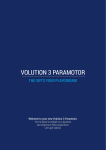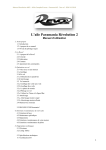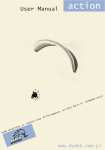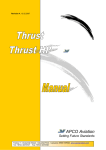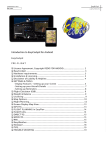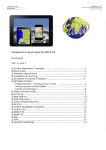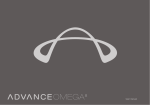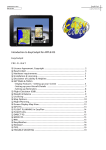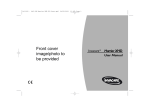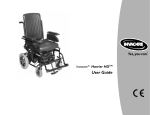Download GTX Owners Manual
Transcript
Owner’s Manual 1.1 1.2 1.3 2 2.1 2.2 2.3 2.4 3 3.1 3.2 3.2a 3.2.b 3.2.c 3.2.d 3.2.e 3.3 3.3.a 3.3.b 3.4 3.5 Introduction About this Manual – more than just a simple manual. Pilot skill level About your Paramania GTX The design and technology of your GTX and how to use it. Reflex The Construction of your GTX What your new Wing comes with Flight Setting up the controls – Pre flight checks Operations - See also Paramania videos on website. Forward launching in zero wind Reverse launching in stronger winds The Climb out In flight handling Using the Trimmers and Speed Bar Landing Power-off landings Power-on landings Advanced manoeuvres Golden Rules!!! Certification and Testing Summary / Conclusion 4 4.1 4.2 4.3 4.4 4,5 Care & Maintenance Manual Basic Care Periodic Maintenance Repairs Care and maintenance of your power unit Care and maintenance of the pilot Wing Inspection Form GTX Specific Technical Manual 5 Technical Data 5.1 Riser diagrams 5.2 Lining tables & diagrams 5.3 Technical Specifications 5.4 EN Data Labels 1.1 Introduction Since inventing the original Reflex wing, the Reflex MK1 in 1994, Paramania feels privileged to have progressively improved levels of safety, speed, performance, and ease of handling in the sport of paramotoring. Paramania is the only manufacturer to focus 100% on wings for powered flight using Reflex technology: the resulting wings we call 'Powergliders'. Our ongoing evolution of Reflex technology for soft wings is reflected by our designer, Mike Campbell-Jones's series of wings: The Reflex MK1 The Reflex MK2 The Action, The Revolution The Action GT The GoFly The Fusion The Taxi The Revolution 2 The GTR The GTX 1994 1997 2002 2005 2006 2007 2008 2008 2010 2011 2012 Mike's experience gives the Paramania team the leading edge - the ability and insight to design wings that consistently bring new technology to the foreground. 1.2 About this Manual This manual is to help you understand your Wing, please read it carefully and regularly! It offers you, the pilot, guidelines in the use of your Wing. It is in no way intended to be used as a training manual for this or any other paramotor wing or paraglider. You may only fly an aircraft of any description when qualified to do so or when undergoing training from an accredited school or instructor. The flying information in this manual is for powered rather than free flying flight. Most of the flight operations described are demonstrated in videos on the Paramania website. www.paramania.com Accompanying this manual you will find : 1) A Care and Maintenance Manual for you and your wing's ongoing safety and efficiency. At the rear of this is the Wing Inspection Form required for ongoing Paramania care of your wing. 2) A Wing Specific Manual - performance capacities, variants on flying techniques, and technical data specific to the type of Paramania Wing you have chosen. It must be understood that flying can be a dangerous activity unless undertaken by properly trained people flying in a responsible and disciplined manner. As the owner of a Paramania Wing, you have chosen to fly one of the safest aircraft of its type available. Nevertheless, in the final analysis, any aircraft is only as safe as the pilot flying it, and it is you, the pilot, who is responsible to ensure that you have the required training (see the Paramania website) and experience to make your own informed judgements about how, where, and when, you fly. Paramotoring (powered paragliding) is a relatively new activity that is still evolving. Should you have any doubts about the suitability of your Wing for the type of flying you wish to practice, or should you wish to extend your flying in other ways, we recommend that you seek further guidance from your own instructors or direct from Paramania. Under no circumstances should you attempt to copy the type of flying that may have been demonstrated to you or that appears on any video demonstration of the wing without first receiving proper aerobatics training from instructors experienced in the use of your chosen wing. In order to achieve satisfactory performance it is essential that proper consideration is given to matching your GTX with the appropriate harness, motor and propeller.* While we can make recommendations, the choice and suitability of any particular harness or motor remains outside our control and responsibility. All such advice is available from our dealer network and other professional training centres. Paramania, its directors, employees and agents can accept no liability for any consequences arising from the use of their products howsoever caused. Pilot skill level A Paramania Wing can adapt to suit the conditions and type of flying a pilot wishes to do. Ideally you will have chosen a wing that will satisfy and teach you for years to come and will allow you to develop your skills safely. If you have any concern about your level of skill simply contact a Paramania dealer or a school and take more training. 2.1 About Your GTX Its design, the technology used in it, what this offers to you, the pilot, and how to make the most of it. The GTX is in a class of it’s own, totally different from others. It’s specifically designed profile and steering system puts this wing on a tip with ease at the same time automatically self centers. Utilizing Mike Campbell-Jones long running experience in soft wing development Paramania have taken wing design to a whole new level. With a relatively low aspect ratio, the large wingtip area adds new meaning to roll rate. Once banked in a turn and and with intuitive use of both brakes; direction and turn radius are can be sharp, snappy and fun! In the hands of experienced pilots this is the perfect wing for slalom, the wing specializes in precision and speed with 100% reflex ability to cut through low level turbulence yet is still simple and easy to use. Fly high and let the trim out to full Reflex with speed bar for maximum speed in a straight-line. Depending on wing load and thrust the GTX can be very fast. This wing comes standard with micro lines on the upper cascades, new WTS steering system, a modified version of Composite Leading Edge (CLE). The risers have a fast trim mechanism that can slow the wing in an instant and the speedbar can be used in all trim positions with impunity. This is known as the PK system. 2.2 Design Your Wing has been designed by Mike Campbell-Jones. His history in the development of powergliders that exclusively use Reflex wing sections, coupled with his experience in Microlight aircraft and glider design, mean that your Wing benefits from a wealth of knowledge that spans over 30 years, back to the early days of hang-gliding. Microlights were initially developed as powered hang-gliders that over time favoured more powerful engines and smaller more stable wings. It soon became clear that the faster your wing, the more often you could use it! The innovations Paramania have brought to wings for paramotor flying mean that the pilot needs to spend less time and effort flying actively, responding to every lump and bump. Leaving the pilot freer to focus on navigating, getting comfortably from A to B, or performing other tasks, such as photography, observation or general flying. The Reflex revolution Although your wing has been designed to fly like a conventional paraglider, it has a Reflex wing section – this is a specific type of wing section that has an elevator built into its shaping making it auto-stable and pitch positive. i.e. It is a wing with built-in pitch stability. It was originally developed for tail-less aircraft (where no fuselages or elevators were fitted). When introduced into a paraglider type wing it gives desirable pitching characteristics. The wing is no longer dependent solely on payload as its only source of stability. It maintains its own 'attitude' or angle of attack in pitch, rising and falling through thermals and turbulence, whilst remaining stable above the pilot’s head, requiring minimal control input. As a result more than 50% of wings used for paramotoring are now Reflex wings. About Reflex technology Paramania’s design history and pioneering developments in Reflex technology (since 1994), have given us the experience to devise wing sections and trimmer systems that allow a pilot to trim safely from paraglider to powerglider, changing the shape of wings to match the requirements of paramotor flight. Many wing manufacturers entering the paramotoring market claim different variations of the Reflex theme. However for Paramania the vital characteristic of the Reflex wing is that it is pitch positive: the wing will pitch forward on entering, and rearward on exiting, a thermal. A normal paraglider wing pitches rearward on entering and forward on exiting. It is most noticeable when flying through turbulent air or thermal activity and requires more pilot input than a reflex (positive pitching) wing. It has now become clear that without the introduction of Reflex technology in wing sections we would have seen many more accidents, as the necessary pilot skills required to fly normal paragliders with engines at low level in turbulent conditions are extremely high. In fact Reflex is the single most important reason why our sport has been able to evolve - it has made it safe for paramotoring flight to develop! See diagrams below “ Reflex wing section” About the CLE (Composite leading edge) system Our new Composite Leading Edge technology: - The word “composite” describes 2 or more elements brought together to create a new material with desirable engineered properties. Our latest composite, Dacron™ with Nylon66, is strategically placed to work in compression. The result is a unidirectional stiffness, which holds inlets open and smooths the leading edge, whilst maintaining the flexibility designed to reduce the risk of cravats. Launching is a totally new experience with this system. Why the larger centre sections (fuselage)? There are 3 principal reasons. 1. Structurally – In general, when paragliders are constructed with increased aspect ratio, the centre chord of the wing becomes relativly narrower, so less ridged, increasing the volume and depth at the centre of the wing, allows us to produce a wing with a higher aspect ratio whilst keeping the same levels of stiffness as a wing with less aspect ratio. 2. Aerodynamically - The larger centre cells behave as a “wing strake” or barrier. This helps to control the 'span-wise' airflow, which reduces induced drag and giving better directional stability. Note: - All birds and most aircraft have a central fuselage! 3. A large centre rib also provides a method of linking the lines from both sides, giving faster inflation and improved launching because the pilot weight is transferred to both sides at once. This is the same as cross bracing on a paragliding harness, only installed as an integral part of the wing. Why the “Centre Keel Lines”™? Both sides of the wing are linked through “Centre Keel Lines”™, which allow a more controlled weight shift movement from side to side. The pilot is thus able to transfer weight without much deformation at the centre of the wing. Further, both sides being linked improves tuck recovery dramatically, as the pilot’s weight is always loaded on more than just half of the wing. ***insert photo Seen here the Wing has minimum distortion at the centre during a heavily shifted turn. 2.3 Construction We produce our wings with Gin Gliders based in Korea, Gin’s renowned precision and quality is clearly visible in all our wings and like all Gin’s products our wings carry a lifetime guarantee. Your wing's strength and durability has been achieved through innovative design and the careful choice of the best modern materials. All materials from which it is constructed are batched and every stage in its manufacture can be traced to a named operator and checker. The top and bottom surfaces are made from the hard-wearing Porsha-Marine NCV, 44g and 37g respectively. The wing tips, leading, and trailing edges are reinforced using a mix of load tape and Mylar. The semi-closed leading edge improves the aerodynamics whilst stabilizing lateral movement between surfaces, giving it a more solid or rigid feel once in the air. The structural ribs These have been designed with inclined oval ports that allow air to flow to the areas within the wing where internal pressure is needed most. They open like valves to increase their area during inflations when the ribs are off-load, and when loaded distribute the forces efficiently from the line attachment points into the top surface, so minimizing distortions normally created by conventional holes. Suspension line attachments are reinforced in 3 dimensions: vertically with the main rib, at an angle with the diagonal ribs, and at 90 degrees with bottom surface lateral tape. The ribs are heavily reinforced with Mylar wherever the loads are substantial i.e. around the 'A' and 'B' line attachments. The special line configuration Unlike conventional structures which are only as strong as their weakest link, a paraglider has a structure closer to that of a tree where the outer branches are less critical and the structure can remain functional and coherent even if outer parts of it break. i.e. you could even lose half a wing and still fly provided enough of the the 'trunk', 'A' lines, are intact. Your Paramania Wing maximises the safety of this structure by having many extra lines towards the tips, these lines act as a net, dramatically reducing the possibility of cravats (for an explanation of cravats see section 3.4). All the angles of the lines are individually calculated to act as a fabric gathering system for the complex changes of our latest Reflex aerofoil. Thus the Wing can actually change its shape, much as a bird trims its feathers! The line configuration and diagonal rib structure share similar angles throughout the wing. This further enhances the load distribution; we have found this gives much quicker inflation. All lines are made from the latest in line technology, Paramania uses a mix of the highest quality lines available which are both strong and flexible, remain temperature stable, and are less prone to shrinkage when lightly loaded. The malions, which attach the lines to the risers, are made of polished stainless steel. This avoids corrosion and gives excellent strength and durability. The riser material is polyester webbing. The main attachment points are reinforced with Cordura, to protect against wear from the karabinas. Your Wing has been built with paramotoring in mind - when new it has a safety factor of approx 50% over and above its tested loading. It has been engineered to perform to its specifications for about 400 hours. WARNING: Humidity and/or UV exposure will drastically reduce the lifespan of your wing. Always store your wing in dry and dark conditions. (See your Care and Maintenance Manual) A comprehensive list of all materials used in your wing is to be found in your Wing specific technical manual. 2.3 What your new Wing comes with The Wing User Manual (USB key) Paramania rucksack Multibag quick pack Inner bag & compression strap Speed bar Basic repair kit, including spare primary “A” lines – these being the most commonly damaged and the most critical. Various Paramania accessories Your Wing is an aircraft As such it has been fully inspected, firstly by the factory, and secondly by your local Paramania dealer. Should you not be entirely satisfied with your Paramania powerglider please contact your dealer directly. (And if you’re happy contact them anyway) 3 Flight The following applies to powered flight. For free flying we recommend all pilots contact a local paragliding school to extend their skills to encompass free flying. The correct matching of the wing, harness, motor unit and pilot is vital. Please take guidance on this. Paramania cannot be held responsible for the multitude of combinations possible, however if you wish to contact us we can offer some advice. NOTE: Thorough pre-flight checks of wing, harness and engine are essential prior to any launch. 3.1 Setting up the controls for the first time - Preflight checks: Hang Test The following is best carried out by an instructor or at the very least by an experienced motor pilot. Before flying your Wing with a motor unit, Paramania consider it necessary to do a static hang test. This is done by hanging your motor unit from an appropriate structure from the wing attachment points by using a strong rope or strap, then by sitting in the harness, and getting an assistant to measure up the risers from the hang points up. The aim is to make sure that you, the pilot, are able to reach the brakes whilst in flight and to ensure that the motor is hanging at the correct angle. Allowance should also be made for the wind blowing the toggles out of reach. All new wings leave the factory rigged for low hang points. It is best to seek professional advice and assistance from Paramania or a qualified representative. Brake line lengths The brake lines come clearly marked in two places, this is because the risers have a secondary lower pulley system, specially for high hang point power units (some models now come with a single pulley system which slides up or down for this positioning). Make sure your pulley is in the right position. These line marking positions are fixed and need no adjustment. Stay within the marks - shorter or longer lines may impair safety! Higher hang points require longer brake lines; lower hang points, shorter ones. A useful method for double-checking brake line lengths in case of doubt or if the markings have worn away: Choose a steady breeze of about 10kph. Ground-handle the wing above your head, with an ordinary harness or your motor unit on your back. When the wing is nicely level, check that when the brake toggles are up against the brake pulleys the trailing edge of the wing is not being pulled down. Then as you gently pull the brakes you should have only a few centimetres of movement before they start to pull down on the trailing edge of the wing. Make sure it is the same length on both sides. First Flights To get used to your new wing your first flights should be made using the recommended take off position. i.e. the one that is marked between the ‘fully slow’ and the ‘neutral’ positions. Try flying with a small amount of brake - you will encounter this point at about the one-quarter-brake position where the brake pressures just begin to feel a little heavier. When you have become fully confident with your wing, try experimenting with faster trim-settings, weight-shift and speed bar and enjoy the extra speed and security your Paramania Wing gives you. 3.2.Operations 3.2a Forward launching in zero wind The hardest thing for any pilot is forward launching in zero wind! Paramania have paid special attention to this area: due to Reflex, your wing has been designed to be exceptionally easy, it virtually comes up on its own, rarely over-shoots, and has excellent directional stability. In reality while there may appear to be no wind this is rarely the case and it is essential for aircraft of this type to take off and make the initial climb out to a safe height (relative to the surrounding terrain) into wind. This makes maximum use of the wind and avoids the danger of losing airspeed when climbing out steeply through wind gradient. Particular attention must be paid to trees, power lines and other large obstacles, and to any rotor (vortices) that they may generate. Remember:- when rotor doubles, turbulence increases by a factor of 4. Preparing the wing Lay the wing out, downwind of the motor, so that the lines are fully extended and as if attached to the motor or central focal point, then lay the risers down ready to clip in. Set the trimmers to the take off position (faster settings may be desirable in stronger conditions). Make sure that when warming up the motor you do s o upwind of the wing, in case a gust blows the wing towards the motor, and then cut the motor whilst clipping in. Next carry out the following checks to ensure all correctly fitted and secure: Pilot prepared – clothing safe? Helmet on and fastened? Malions securely connected to risers (no twists) and nuts secure? Trimmers set to correct position? Nothing likely to foul the propeller? Speed bar system correctly fitted, running freely and out of harm’s way? Steering toggles secure, brake lines free and not twisted? Wing Tip Steering (WTS), if fitted, secure and adjusted correctly? Wing securely attached? Motor delivering full power? Airspace is clear for take off? From now on you should try to control the wing whilst facing forwards. If the wing is low behind you and you turn around, the lines may trail over and into the propeller. However, falling backwards onto your motor 'turtle-style' is both dangerous and expensive and must be avoided at all costs, even that of a few damaged lines! During the launch, if the pressure on each of your hands feels even, then move forward, opening the throttle progressively towards full take off power whilst leaning backwards against the thrust so that the motor is pushing you along the ground rather than into it. BEWARE paraglider pilots! A common problem for paragliding pilots not used to motors is leaning forward too much – this may lead to a prop strike on a line if the cage is not strong enough, or worse a hand in the prop. It is best to try and leave the brakes alone and just let the wing come up. If it starts to go off to one side, move sideways and centre the wing. If possible try to maintain the direction of your launch. If the wing starts to drop backwards, increase pressure on both “A” risers to help it up. As you increase power, try to maintain a constant angle with the motor and smooth power control. Any sudden changes will alter your course because of the powerful gyroscopic and torque effects. As the wing comes up the resistance reduces. Until this happens it is best to keep moving and looking in the launch direction, whilst simply feeling the wing, normally it will stabilize over your head without over-shooting. Only when you feel the resistance reduce is it a good time to check your wing, making sure it is nicely inflated and that there are no tangles or lines fouled, however this must be done whilst on the move and without turning. Allow your run to accelerate. Feel for pressure on the brakes, gently come down on them as required to steer or to increase lift for taking off. If the wing is so far off to the side or behind that it cannot be recovered, kill the motor, abort the take-off and reassess the launch conditions. NB Many pilots try to look at the wing as it is coming up, in doing so they usually upset the launch: in looking their body turns - this changes the thrust line, and means the length of the risers is no longer equal. The resulting gyroscopic effects from the prop disrupt the launch. Points to note:- If your propeller protection cage is flimsy, the pressure of the lines on it during launch may distort it to the point where it fouls the propeller. If this is the case make sure the lines have cleared the cage before you open the throttle. Take care paraglider pilots! -All control inputs should be smooth and progressive. - Don’t attempt to take off if the wing isn’t roughly level overhead. Dangerous oscillations may result if you apply full power with it too far off to one side. - Keep your undercarriage down until you are definitely flying! The faster the trim setting, the more brake the wing will need to get off the ground. 3.2.b Reverse launching in stronger winds Paramania recommends this launching method. Since Paramania wings launch so easily it is possible to perform a reverse launch with both front risers and one brake in one hand and the throttle and opposite brake in the other. If the wind is appreciable then this is the easiest method of launching. NB If the wind is light and variable, the difficulty of running backwards safely with a motor on, makes a forward launch preferable. It is wise not to open your wing out to the point where it is liable to be caught by the wind until you are ready to launch, especially if it is already connected to your motor. Prepare your wing by carefully unfolding it, then gather the wing from the risers until you can hold it as a bunch by following a central 'A' line from each side, place them on the ground ready to clip in. Place the wing on the ground with the leading edge facing upwards but still bunched up, and the trailing edge pointing towards the wind. Unfold it just enough to locate and untwist the risers checking that no lines have gone over into the leading edge. Extend the risers upwind as usual, separating left from right. As you clip in we suggest that you pre-twist the risers over each other half-a-turn in the direction in which you wish to turn during launch and lay them out in this position with the rear risers uppermost. This is because, once clipped in, the propeller cage on your back makes it virtually impossible to turn without assistance when the wing is on the ground. Keep hold at all times of the 'D' , the rear, risers to make sure the wing doesn't launch in the strong wind. Carry out your standard pre-flight checks now. Having started and warmed up your motor upwind of the wing, attach yourself to the power unit, face the wing, approach the risers and clip them on to the appropriate malions. By pulling on 'A' and 'D' risers simultaneously the wing will rise up like a wall without taking off, facing the wind and ready to launch. The 'A's encourage the air intakes to present themselves to the wind, the 'D's keep it on the ground. We recommend that you momentarily raise the wing off the ground to check for tangles and line snags and pull it down again using the 'D' risers. Holding risers, brakes and throttle control as outlined above, gently pull the front risers up to lift the wing over your head. The wing is unlikely to over-fly you, especially if it is trimmed to fly fast. If you are a paragliding pilot this may be contrary to what your intuition tells you, but on the faster settings (trim neutral) the Reflex wing section stabilizes the wing and prevents it from pitching forward. When the wing is steady above you, turn around, apply power, and take off. As with forward launching, the trim/power/brake relationship must be established for the best rate of climb and forward speed. Hot Pilot Tips for Take off - Turning around will be much easier if you tilt the wing slightly over into the direction you are about to rotate into. - If at any time you are not happy with your launch, you can simply abort it by lowering the wing to the ground using the 'D' risers. - On uneven ground the leading edge of the wing should be level with the horizon. Points to Note: It is vital to master reverse launching before attempting it under power. It is fun. No amount of ground handling practice is enough! Your local paramotoring/paragliding school may also assist you here. - All control inputs should be smooth and progressive. - Don’t attempt to take off if the wing isn’t roughly level overhead. Dangerous oscillations may result if you apply full power when it is off to one side. - Keep your undercarriage down until you are definitely flying! - The faster the trim setting, the more brake the wing will need to get off the ground. Speed systems may cause problems when clipping in. Don’t get your lines crossed! - Get used to using the KILL switch at all times to reduce expensive line and prop damage. WARNING:- Many pilots, particularly if they have trained previously in paragliding, get into the habit of using the brakes to abort or control their wing in windy conditions - experience has shown us that sooner or later they WILL put a hand back into a spinning propeller. Get in the habit where possible of using the 'D' risers instead – a shorter and more effective movement. 3.2.c The Climb Out Once off the ground and flying safely, continue into wind using the brakes to achieve the desired climb rate. Don't attempt to climb at too steep an angle. Attempting to use too much brake to force a higher climb rate will only degrade the climb by creating extra induced drag, and with the addition of lots of thrust could result in a stall or spin. Under power your wing behaves more like a powered fixed wing aeroplane than a paraglider, and it helps to think of it as such. Provided there are no obstacles in your path, it is often safer to fly level with the ground after take-off, gaining more speed before converting it into considerable height using the brakes and then easing off into the climb out. The other reason for not climbing out too steeply is the risk involved if the motor fails i.e. a stall and diving recovery. Although Reflex wings have high pitch stability, a slow forward speed and high angle of attack are still likely to put you into a state dangerously close to stalling should your power source suddenly fail. Take care to set up a reasonable approach. Don't make things hard for yourself - fly with sufficient airspeed at all times, and keep your airspeed under control at low altitudes. Depending how the hang points are set up on your power unit you will feel to a greater or larger extent the propeller torque. It may be necessary for you to steer against it to maintain direction. NB However if you are countering the torque effect during a steep climb on slower trim settings under a lot of power, take care as there can be a risk of stalling. Because all paramotors have a large distance between the thrust of the motor and wing, applying power suddenly has a bigger effect than a conventional aircraft. Therefore care should be taken especially during climb out and/or close to the ground. 3.2.d In Flight handling As with anything new, we recommend that you get into it gently and don’t rush, give it time, be smooth and concise with the controls, and above all, make sure when you start a turn to finish it properly! Try to imagine your flight trajectory ahead of making it. Power induced oscillations Certain combinations of geometric chassis design, weight, power, and propeller size can cause oscillation where the torque and gyro effects lift the pilot to one side. This usually occurs when climbing rather than in level flight. To counter this you can: • Make sure you complete your turns by being smooth on the controls. And/or • Change the throttle setting and reduce the level of power. And/or • Shift your weight in the harness. And/or • Set up the wing tip steering (WTS) kit or other wing tip device to adjust out the torque effects. Weight shift is the best counter. Oscillation usually occurs on high power settings - more power and a larger propeller cause more oscillation. It could be that your control inputs are amplifying the oscillation. In this case, throttling back a little and flying hands-off should take care of the problem. It is quite common even for experienced pilots to be too busy on the controls, this is referred to as pilot induced oscillation, and the simple answer is to stop moving your hands. Level Flight Once at a safe height after take off, if you wish to go cruising reach up and let off the trimmers to a faster setting, and completely let go of the brakes. If you are a conventional paragliding pilot it may take time to gain sufficient confidence in the wing to do this, but once you do you'll discover a whole new world! If conditions are very rough you may wish to keep hold of them, however Reflex wings are even more stable at higher speeds, so we do suggest you let go of the brakes and enjoy the flight. If wing tip steering (WTS) is fitted, use it to maintain level flight. WTS really helps hold your course particularly when thermals get under one side of the wing. 1 WARNING All paramotors should have adequate netting to prevent toggles entering propellers whilst in flight – check yours! This CAN happen during flight particularly while weight shifting. Make sure you are set up properly by using the Hang test. If you have an alti/vario, keep an eye on it. Whilst in level flight it is easy to creep into a climb without noticing. Use the information from your instruments to optimize your forward speed and reduce drag and fuel consumption. This will all be specific to your own set up. With a sound understanding of the current wind conditions at different altitudes, and intelligent use of any thermal activity, wave, convergence, ridge or frontal lift, it is possible to conserve your fuel and greatly extend your operating range. The motor of course makes it easy for you to get yourself into the right place at the right moment to best exploit the conditions. Don't be afraid to throw the wing into a tight thermal to gain height and save fuel - you will find it is particularly good at thermals. Use of slower trim settings will allow you to climb faster. 3.2.e Using the Trimmers and Speed Bar Reflex wing sections are unique – the greatly extended range of trim positions in which you can carve turns, and the speed bar for you to explore. You will not get bored. We ask only that you explore the full flight envelope at a safe height and with adequate training and experience. Get to know your speed bar! We can’t emphasise enough the value of using it. It may increase speed by as much as 30%, and, in the right conditions, it can greatly enhance your manoeuvrability, stability and safety. The wing cuts through turbulence even better with the bar applied. However, if any instability is encountered due to excessive turbulence it is recommended to release the bar for recovery and to return to normal flying mode. The speed bar is primarily for use during straight and level flight. As you become more proficient, careful release of the bar whilst entering turns, has an effect similar to pulling the stick back on a conventional aircraft. For correct trimmer usage, first study the diagrams specific to your wing, showing trim and speed bar movement as well as speed bar hook-ups. The diagrams also show you the effect on the wing's aerofoil shape relative to the different trimmer settings, as well as the Centre of Pressure (CP) changes indicating differing levels of pitch stability. Paramania wings generally have a remarkably large and relatively safe speed range: 3.5 times greater than its stall speed as compared with most aircraft that only have 1- 2.5 times. With the trimmers fully off the wing’s speed and stability increase and hence its ability to cut through turbulence and cover distance improves. On faster trim or speed bar settings, brake pressures generally increase and then weight-shift or wing tip steering (WTS) become more effective and safer. Bear in mind that use of the brakes detracts from the benefits of Reflex in a wing as it may distort the wing's shape making it less stable. On the slower settings, sink rate improves dramatically and handling on the brakes becomes much lighter enabling you to make the best use of thermal cores and will improve your climb rate and give shorter, slower take-offs and landings. As your skill improves at all speed settings the differential application of both brakes while banking will allow you to make very effective turns by increasing the lift to assist the turn when the lift axis is angled towards the bank. Likewise motor thrust and speed bar can be applied at certain times to increase turn rate etc. These techniques come with pilot experience and allow you to get the most from your wing and achieve fully coordinated, smooth turns, much like those possible on a three axis aircraft. Points to Note: • Remember, trims and speed bar are controls, so are extra items for your pre-flight checks! • If the trim settings inadvertently become asymmetric, the wing just crabs. Likewise, if lift is dumped, by releasing the trimmers accidentally, don't panic just correct the trimmer position. NB If trimmers aren't set correctly before launch or slip asymmetrically during launch it is best to abort and start again. • In general, when flown with the higher hang-point motor units, the wing has more of a tendency to dive when entering turns, this may also result in higher ‘G’ loadings in tight turns and bigger 'swing-throughs' when exiting manoeuvres. Weight shift is usually less effective with high hangpoints. However usually extra pendulum and lateral stability is gained. 3.3 Landing There are two options: with the motor running or not. 3.3.a Power-off landings It is excellent training to practise with the motor off at all time. Your wing has a good glide angle so forward planning of your approach is required. Cut all power at about 50m and glide in like a paraglider. This minimises the risk of propeller damage however you only get one go at it - you have to get it right! During the landing 'flare', the brakes, light at first, become progressively heavier over a healthy amount of travel, giving plenty of warning of a stall. With or without power the wing being Reflex, handles turbulence better on a fast trim setting, so if it is rough come in fast (on neutral trim), allowing yourself plenty of room to bleed off speed just above the ground before touching down. The wing stores energy well and it may be necessary to round out and 'float' level with the ground, converting your excess speed into lift while you slow down, before flaring to touchdown. On landing in high winds the wing may be deflated with confidence using a strong pull on the rear or 'D' risers, or, off to one side with a brake, in which case it is a good habit to watch the wing tip go down - it will save propellers etc! If you aim at a restricted or tight landing area, in zero-wind conditions, it is advisable to use take off or even full slow trim (maximum lift configuration). This will hardly alter your glide angle but will decrease your sink rate and forward speed, these types of decisions become more critical at higher wing loadings. Practice makes perfect! Why not use your Paramania multi bag as a spot landing! 3.3.b Power-on landings At a steady-tick over, lose height at a shallow angle, then as you near the ground, level out and bleed off speed before flaring to touch down. Kill the motor as your feet touch the ground. The advantage of this method of course being that, if at any time you feel your approach is wrong, you can power up and go round again. The disadvantages if you do come in wrong are the increased risk of (expensive) prop damage, the dangers involved in falling over with the motor running, and in getting your lines in the propeller if you are late to switch off before the wing deflates. Points to note: • If possible, find out all about your landing area before you take off particularly if flying a wheeled unit. • Check the wind direction before you set up your approach and any potential sources of turbulence (rotor). • Power-off landings probably need less space. • If in doubt, practise your approach until you are sure you can land safely. • Never rely on your motor - always be ready for an emergency landing by practising spot landings regularly. 3.4 Advanced Manoeuvres It is essential that pilots undertake proper training before attempting certain aerobatics. We suggest that you seek advice from instructors or experienced pilots before conducting ANY of these manoeuvres or before flying in extreme conditions, and you should definitely carry a reserve parachute if this type of flying is for you. ‘Big Ears’ This method is a good and safe way to descend, however, care should be taken when pulling down the outer 'A' lines not to pull them too far as there is a lot of load on the 'A's especially on the faster trim settings. Note:- We do not recommend using Big Ears with a lot of power/thrust as there is a slight risk of stable stall. Adverse flight reactions Cravats A cravat occurs when part of the wing fabric makes its way between lines and gets caught there. This usually happens after recovery from a major deflation caused either by severe turbulence or foolishly induced by the pilot. Normally pumping the brakes will unravel the wing, if not, then a sharp pull on the 'B's or 'D's usually does the job. Paramania have increased line density near the tips, which reduces the possibility of cravats. Stable stall When any wing has flown many hours or has been over-loaded, one of the first signs of degradation is a tendency towards stable stalling. This may occur whilst exiting a high-energy or advanced manoeuvre. A stable stall can even occur during a low airspeed take-off, usually when a motor too powerful relative to the pilot weight and wing loading is being flown. It is also most likely on the slow speed trims. Should you find yourself in this situation:In flight The quickest recovery is achieved by coming off the power (if any), giving a short sharp pull on the brakes in unison, followed immediately by a firm and even pull on both 'A's at once. If you are too low to brake then just do the even pull on the 'A's. During take-off ALWAYS ensure that your wing is definitely flying with enough air speed, before opening the throttle or pulling on any brakes during a launch. If it does happen that you have managed to leave the ground but are not fully flying, DO NOT add more power or more brakes but smoothly come off them. If the wing does not accelerate, just land. Re-assess the conditions as it may well be that you are trying to climb out through a wind gradient. Stalls and Spins If a wing stalls or spins it is usually because the pilot has applied too much brake to both or one side. It is flying too slowly. A stall is when both sides of the wing have insufficient airspeed to continue flying. A spin is when one side only is stalled. So the wing starts to rotate around its centre axis. (Too much power to weight ratio does not help these situations). The remedy is to simply ease the brakes off smoothly and come off the power in order to exit and regain flight. Warning:- Stalling or spinning are common to all aircraft that take off or fly with insufficient air speed. In addition the thrust line on a paramotor is well below the wing, so adding power adds to the problem. Sometimes pilots panic and apply more power or more brake - this is definitely the wrong thing to do! Be aware of the dangers and study your theory of flight. All of these manoeuvres and the recoveries from them, are taught on SIV (Advanced Manoeuvres Clinic) courses. Contact a local paragliding club for more information about SIV. 3.5 Paramania’s GOLDEN RULES! Wing + Motor + Pilot = Paramotoring. 3 primary elements linked as one. Over the last few years we have seen amazing advances in our sport. In particular – wings and motors have come a long way. However it is doubtful that we as pilots manage to keep up with these advances. Keep yourself trained up and informed of new developments. Paramania’s Golden Rules is a list of sensible rules to help you keep safe compiled by Mike Campbell-Jones. - Always fly with at least 3 options open to you at all times. If you find yourself with fewer, search for more right away. You are at RISK! (This rule applies to the entire activity.) - If you spot a problem, no matter how small, deal with it NOW! - Never rush anything, take your time, stay cool (after all you are a pilot now). - Understand the theory of flight – take the time to do this. - 75% of paramotor accidents happen around propellers on the ground. Clear people away from around your propeller and ensure that they are standing in the safety zones. - Before you start your motor get in the habit of shouting “CLEAR PROP” to remind also yourself of the necessary safety precautions. - Don’t be too shy or too proud to ask for advice especially from local experienced pilots. - Understand the weather, (including micro-met). - Always carry out full pre-flight checks before launching. - Check, check and re-check the fuel system for leaks. - Make sure you have enough fuel to get you to your destination. Better too much than too little! - Check for any loose articles that could trail or fall into the propeller while flying and fasten them securely. Ideally wear a flying suit into which everything can be zipped in (available from the Paramania webshop). - Never place your motor downwind of your wing. - Always put on and fasten your helmet before clipping in to the harness. - Never rely on the motor - it may cut out at any moment. Always fly as if it will so fly the wing – NOT the motor - Scan the sky at all times - know where the others are all of the time! - Don't fly into danger i.e. over water, trees, rough terrain where a motor failure will leave you in trouble (water in particular). - If you see pylons or poles, between them there will be power lines. Know where they are, especially if you are low. They are one of our biggest hazards! - Avoid downwind low flying - it drastically reduces your options! - Try not to fly into the turbulence of your own wake or that of others, especially at low altitude. - It is unwise to fly hands-off below about 100m AGL. Especially as a motor failure will require you to make immediate control inputs to set up a landing approach. - Be sensitive to mechanical problems early on. A noticeable change in motor tone or a new vibration may spell trouble. Land and check it out. - Make sure your navigation and knowledge of air law and local regulations are up to the job. Study your local air charts, every country has these. - Remember, not everyone enjoys the noise of your motor. - Care must be taken when flying near livestock, (especially over pig farms or horses) and other sensitive areas such as nature reserves. Pay great respect to landowners and farmers, look after them, we need them! Paramania carry out our own tests to a high standard. Most of our wings additionally go through EN paraglider testing and are awarded a rating. All our wings are registered in France under the DGAC which has the status internationally of individual countries' aviation authorities. This means we, as any other aircraft manufacturer, assume a level of responsibility for our products. We take pride in our level of technical knowledge and only sell equipment that has the highest safety levels. SUMMARY Pilot prepared – clothing safe? Helmet on and fastened? Malions securely connected to risers (no twists) and nuts secure? Trimmers set to correct position? Nothing likely to foul the propeller? Speed bar system correctly fitted, running freely and out of harm’s way? Steering toggles secure, brake lines free and not twisted? Wing Tip Steering (WTS), if fitted, secure and adjusted correctly? Wing securely attached? Motor delivering full power? Airspace is clear for take off? Include: toggles, leaning forward with prop turning static hang test brake lines set speed bar karabinas We would like to stress again the points made in Section 1 of this manual: It must be understood that flying can be a dangerous activity unless undertaken by properly trained people flying in a responsible and disciplined manner. As the owner of a Paramania Wing, you have chosen to fly one of the safest aircraft of its type available. Nevertheless, in the final analysis, any aircraft is only as safe as the pilot flying it, and it is you, the pilot, who is responsible to ensure that you have the required training and experience to make your own informed judgements about how, where, and when, you fly. Although this is not a training manual it does contain vital lessons from our decades of flying and useful common sense tips that will help you fly well and keep you safe. We welcome you to visit the Pilot Space on the Paramania website. It is for you, for updates, exchange, as well as for the optimum ongoing care of your Paramania wing. This Paramania Manual is subject to continuous updating - to assist us in our quest for perfection, we would appreciate any input that you the user may wish to contribute towards future versions. Please don’t hesitate to contact us with your views and suggestions. The team wish you many hours of fun beneath your Paramania Wing. The Paramania Team www,flyparamania,com info@flyparamania Annexes :



























